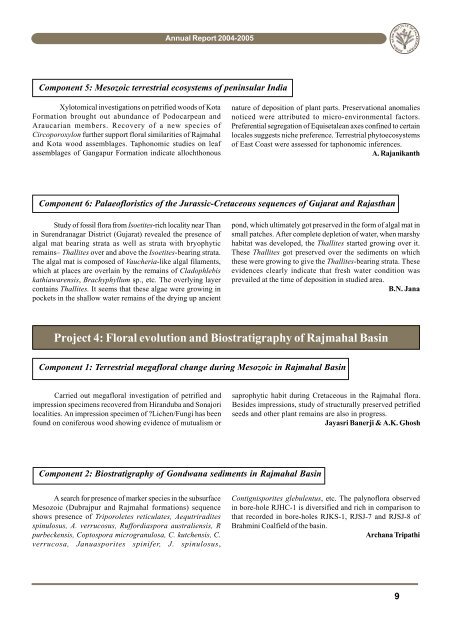english final - Birbal Sahni Institute of Palaeobotany
english final - Birbal Sahni Institute of Palaeobotany
english final - Birbal Sahni Institute of Palaeobotany
Create successful ePaper yourself
Turn your PDF publications into a flip-book with our unique Google optimized e-Paper software.
BIRBAL SAHNI INSTITUTE OF PALAEOBOTANY<br />
Annual Report 2004-2005<br />
Component 5: Mesozoic terrestrial ecosystems <strong>of</strong> peninsular India<br />
Xylotomical investigations on petrified woods <strong>of</strong> Kota<br />
Formation brought out abundance <strong>of</strong> Podocarpean and<br />
Araucarian members. Recovery <strong>of</strong> a new species <strong>of</strong><br />
Circoporoxylon further support floral similarities <strong>of</strong> Rajmahal<br />
and Kota wood assemblages. Taphonomic studies on leaf<br />
assemblages <strong>of</strong> Gangapur Formation indicate allochthonous<br />
nature <strong>of</strong> deposition <strong>of</strong> plant parts. Preservational anomalies<br />
noticed were attributed to micro-environmental factors.<br />
Preferential segregation <strong>of</strong> Equisetalean axes confined to certain<br />
locales suggests niche preference. Terrestrial phytoecosystems<br />
<strong>of</strong> East Coast were assessed for taphonomic inferences.<br />
A. Rajanikanth<br />
Component 6: Palae<strong>of</strong>loristics <strong>of</strong> the Jurassic-Cretaceous sequences <strong>of</strong> Gujarat and Rajasthan<br />
Study <strong>of</strong> fossil flora from Isoetites-rich locality near Than<br />
in Surendranagar District (Gujarat) revealed the presence <strong>of</strong><br />
algal mat bearing strata as well as strata with bryophytic<br />
remains– Thallites over and above the Isoetites-bearing strata.<br />
The algal mat is composed <strong>of</strong> Vaucheria-like algal filaments,<br />
which at places are overlain by the remains <strong>of</strong> Cladophlebis<br />
kathiawarensis, Brachyphyllum sp., etc. The overlying layer<br />
contains Thallites. It seems that these algae were growing in<br />
pockets in the shallow water remains <strong>of</strong> the drying up ancient<br />
pond, which ultimately got preserved in the form <strong>of</strong> algal mat in<br />
small patches. After complete depletion <strong>of</strong> water, when marshy<br />
habitat was developed, the Thallites started growing over it.<br />
These Thallites got preserved over the sediments on which<br />
these were growing to give the Thallites-bearing strata. These<br />
evidences clearly indicate that fresh water condition was<br />
prevailed at the time <strong>of</strong> deposition in studied area.<br />
B.N. Jana<br />
Project 4: Floral evolution and Biostratigraphy <strong>of</strong> Rajmahal Basin<br />
Component 1: Terrestrial megafloral change during Mesozoic in Rajmahal Basin<br />
Carried out megafloral investigation <strong>of</strong> petrified and<br />
impression specimens recovered from Hiranduba and Sonajori<br />
localities. An impression specimen <strong>of</strong> ?Lichen/Fungi has been<br />
found on coniferous wood showing evidence <strong>of</strong> mutualism or<br />
saprophytic habit during Cretaceous in the Rajmahal flora.<br />
Besides impressions, study <strong>of</strong> structurally preserved petrified<br />
seeds and other plant remains are also in progress.<br />
Jayasri Banerji & A.K. Ghosh<br />
Component 2: Biostratigraphy <strong>of</strong> Gondwana sediments in Rajmahal Basin<br />
A search for presence <strong>of</strong> marker species in the subsurface<br />
Mesozoic (Dubrajpur and Rajmahal formations) sequence<br />
shows presence <strong>of</strong> Triporoletes reticulates, Aequtriradites<br />
spinulosus, A. verrucosus, Ruffordiaspora australiensis, R<br />
purbeckensis, Coptospora microgranulosa, C. kutchensis, C.<br />
verrucosa, Januasporites spinifer, J. spinulosus,<br />
Contignisporites glebulentus, etc. The palyn<strong>of</strong>lora observed<br />
in bore-hole RJHC-1 is diversified and rich in comparison to<br />
that recorded in bore-holes RJKS-1, RJSJ-7 and RJSJ-8 <strong>of</strong><br />
Brahmini Coalfield <strong>of</strong> the basin.<br />
Archana Tripathi<br />
9

















